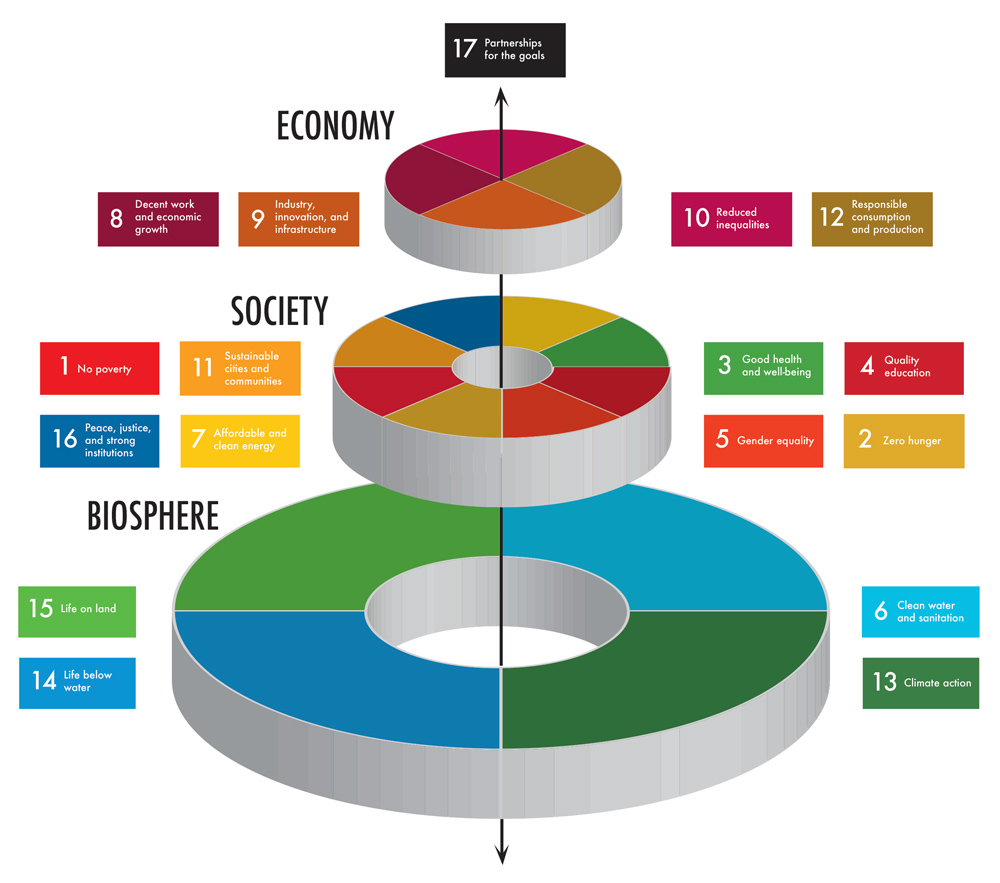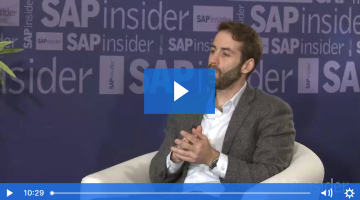SAP and the Circular Economy
By Enabling a Zero-Waste Value Network, SAP Can Help Customers Reap Financial Benefit While Delivering Environmental and Societal Impact
The global plastic crisis is real. People in every country around the world have seen its results: overflowing barges and landfills, oceans teeming with microplastics, sea life threatened or killed from ingesting or getting entangled with its often brightly colored piles of waste, and its potential impact on human health. With eight million metric tons of waste being dumped in the ocean each year, and the amount of plastics produced and consumed expected to double over the next decade, it’s projected that the world could see as much as 250 million metric tons of plastic in the ocean in under 10 years.
While there are eight official categories/types of plastics (or polymers), ever-progressing product innovation is causing thousands upon thousands of variations, which complicates the ability to recycle it. Most countries ship their plastics elsewhere — with seven million tons per year (as of 2016) being shipped to China alone (700,000 of which came from the US) — versus the home-turf option of creating massive landfills. However, with China banning nearly all imports of plastics in January 2018, that plastic is now being shipped to other countries, such as Malaysia, Vietnam, and Indonesia, that don’t have the capacity to recycle it or dispose of it safely.
In response to this situation, policymakers, society, and leading companies are already coming together to work on solutions — by avoiding single-use plastics, better managing and recycling the plastic waste stream, and creating a circular plastics economy.
For example, companies in the consumer-packaged goods industry have started rethinking packaging and opting for more recyclable and sustainable alternatives. And this concept of stopping waste streams by better management of materials extends beyond plastics. For instance, the steel industry is setting a standard in recycling metals — steel is a material that can be infinitely recycled and is 100% recyclable without loss of quality, which is why it is currently the most recycled material in the world.
With 77% of the world’s transactions touching SAP systems and more than 430,000 companies using SAP software, that represents a big opportunity for SAP to make a difference helping customers redesign global value networks toward more circular business models.
Introducing the Circular Economy
Clearly, the traditional model of “take, make, use, dispose” is no longer viable for the sustainability of the planet, and we are at a historic tipping point where the only clear solution is to move toward a zero-waste value network. Zero waste is a core principle of the “circular economy” concept. According to The Ellen MacArthur Foundation, which works with organizations to build a framework for an economy that is restorative and regenerative by design, a circular economy is based on the principles of designing out waste and pollution, keeping products and materials in use, and regenerating natural systems.
“In terms of biological cycles, there’s really no waste in nature. Everything from nutrients becomes recovered and recycled back into the systems, and the idea is that through circular business models, you can replicate that from the perspective of industrial systems by using resources wisely and designing for zero waste,” says Jim Sullivan, Global Head of Sustainability Innovation at SAP. “Currently, our world is only about 9% circular, according to the Circularity Gap report, and we need 1.8 planets worth of resources to sustain the lifestyles we have become accustomed to. Unfortunately, we don’t have that second planet to continue this model for very long.”
Sullivan describes a holistic view of business and society needing to operate within environmental and planetary boundaries, best visualized in the Stockholm Resilience Center’s model for viewing connectivity of the sustainable development goals (SDGs), shown in Figure 1. “If business doesn’t adequately address global challenges, such as plastics leakage, you will see society putting a lot more constraints on the use of these plastics and other problematic single-use materials,” he says. “And if society doesn’t address the topic in a way that allows business to profitably operate within the planetary boundaries, there becomes a real danger to the continuing function of society — let alone business growth within that society.”

Figure 1 The model of viewing connectivity of the Sustainable Development Goals (SDGs) where the economy serves society so that it evolves within the safe operating space of the planet
According to Sullivan, who previously spent over eight years working for the US Environmental Protection Agency, where he was focused on climate and energy issues, if even a small portion of those plastics are redirected, that can have a tremendous impact. “If we reduce leakage from the seven largest rivers in Asia by 20% per year between now and 2030, as data from the 5 Gyres Institute has shown, we can return ocean plastics down to pre-1990 levels.”

Currently, our world is only about 9% circular, and we need 1.8 planets worth of resources to sustain the life styles we have become accustomed to. Unfortunately, we don’t have that second planet to continue this model for very long.
— Jim Sullivan, Global Head of Sustainability Innovation, SAP
Sustainability and purpose have become vital topics for SAP customers, according to Sullivan, and have led to new opportunities for SAP to engage to help customers achieve their purpose around sustainability. SAP recently celebrated its 10th anniversary of delivering on its sustainability strategy. (To see what SAP’s sustainability strategy consisted of 10 years ago, read this SAPinsider article, which reviews SAP’s sustainability roadmap from 2009.) Since that time, the company has been recognized by the Dow Jones Sustainability Indices as the world’s most sustainable software company and has expanded its efforts with external councils, alliances, and keynotes as well as participation in summits to drive progress on SDGs. SAP also has looked to its own customers and non-governmental organizations (NGOs) for advice on longer-term strategy.
Looking back over SAP’s history, an area in which the company has excelled is managing business processes and resources (financial, material, and human resources) for a wide variety of SAP’s 400,000+ customers. “When planning where we can move the needle on sustainability over the next 10 years, we looked at how we can take all the lessons learned around resource productivity over the past 40+ years, and apply them in a more circular manner,” Sullivan says. “Last year, we came out with this aspiration of a world with zero waste, and we look to work with our most strategic customers to create exactly that.”
Working with Customers and Partners to Create a Zero Waste World
There are many ways that SAP is working with its customer and partner base to help move the circular model forward. One avenue is in creating and posing challenges to the global innovation community. For example, SAP teamed up on a project with Google to pose a Circular Economy 2030 challenge to social entrepreneurs where contestants were asked to propose a revenue-generating idea that used both Google Cloud Platform and SAP solutions to advance a circular economy. The contest, which was announced at Davos in January 2019 and received applications from over 50 countries, had five finalists announced at Google Next, and the winner was then revealed at SAPPHIRE NOW in May 2019.
SAP and Google went through a series of deep-dive workshops with the contest’s finalists, which included use cases around real-time waste tracking, creating solar cold-storage for farmers, ensuring surplus food after high-density events (like the Superbowl or SAPPHIRE NOW) is donated appropriately, making end-to-end battery life circular in the supply chain, and repurposing scraps from the apparel industry. The winner — a company called Topolytics — created an app (using Google mapping and SAP analytics) for real-time tracking of waste flows within the UK, which it has since expanded to India and a few other places.
Another challenge that SAP posed last year was the SAP Leonardo Plastics Challenge to see how SAP, customers, and citizens could use SAP Leonardo technology to design single-use waste out of the world. This project team performed consumer research on the topic by tracking the plastics use of a few dozen UK citizens who volunteered to let SAP capture data around their daily engagements with plastics for one month. As a result of this innovation project, SAP became a member of the UK Plastics Pact, which brings together governments, local authorities, NGOs, and businesses from across the entire plastics value chain to transform plastic packaging and help stop pollution.
Sullivan recently attended the Ocean Plastics Leadership Summit with a number of SAP customers, which was a research expedition to the North Atlantic Gyre to look at the circular economy in the context of the plastic leakage problem into the oceans. The summit — co-convened by SAP and Dow, a large materials science company that is an SAP customer and partner — was attended by 160+ people from companies such as Procter & Gamble, Coca-Cola, Clorox, Kimberly-Clark, HP, and Sealed Air, among others. It got a large number of C-level executives and line-of-business heads deeply involved in the topic — where they were literally swimming in the problem — and then conducted a series of innovation workshops on the ship.
In addition to measuring environmental and societal progress as part of circular material flows, in June 2019 SAP also became a founding member of the Value Balancing Alliance, a nonprofit with the aim of revamping how corporations measure environmental and social progress on the corporate balance sheet. With global warming and natural resource depletion, and public insecurity on the rise, it has become increasingly clear that businesses need to reprioritize the way they measure success as a commitment to all stakeholders. Seven other companies (BASF, Deutsche Bank, LafargeHolcim, Novartis, Philip Morris, Bosch, and SK Holdings) are members, and it is supported by the four big accounting firms (Deloitte, EY, KPMG, and PwC), as well as the Organization for Economic Cooperation and Development (OECD), which is a unique forum that aims to create a standardized model for measuring and disclosing the environmental, social, and financial value companies provide to society.
Sustainable business practices like eliminating waste streams are not just about limiting negative environmental impact — they also make a lot of business sense. The circular economy could unlock $4.5 trillion in growth by turning waste into wealth, as projected in research by SAP partner Accenture. There is a tremendous opportunity in developing ways to track environmental and social information along with material flows throughout value networks, and there are some bold aspirations around the topics of both financial and material flows, according to Sullivan. “On one side, there is a large opportunity today to create new value from materials that were previously disposed or leaking into the environment and to share that value. However, the risk side is rapidly increasing with citizen engagement based on series such as BBC’s Blue Planet II,” he says. “Very few companies were ready for the exponential increase in regulations and consumer behavior changes that are happening this year, and it is becoming increasingly costly for companies to not design for reuse as part of the business process.”
This topic of the circular economy becomes a way that SAP can transform what it has done with customers around optimizing business processes and resource productivity into the next decade and beyond. And SAP technology employed in different use cases across various industries can help companies create those desired circular loops.
“This is a massive global challenge,” says Jennifer Scholze, Global Lead, Mill Products and Mining, Industry Marketing at SAP. “It is now evident with this current generation that business and technology can play a critical role in helping if we all work together. And by the way, there’s a lot of work that is already being done.”

It’s time to act. There’s something everyone can do. The technology to support it is there. Companies just need to be bold and open minded to work together and take the next step.
— Jennifer Scholze, Global Lead, Mill Products and Mining, Industry Marketing, SAP
Uses Cases for Creating Circularity
SAP currently is shepherding a number of circular use cases, and the ones that are in the most advanced states are in the following three areas: plastics and packaging, metals and mining tracking in batteries and high-tech, and capital equipment. After taking all the feedback from the Design Thinking workshops that came out of the Circular Economy 2030 challenge, the SAP Leonardo Plastics Challenge, and the Ocean Plastics Leadership summit, SAP is working on four main use cases with a variety of customers across several different industries to start:
- Secondary materials marketplace: The idea of this use case is to expand the trade of recycled plastics and plastic alternatives by incorporating many existing marketplaces for certain materials in certain geographic regions (via technology such as SAP Ariba Network) to smooth the process of buyers and sellers finding pricing and increasing value around secondary and scrap materials.
- Extended producer responsibility: This use case is for manufacturers to better know precisely where and how their materials are being used. Technology can enable close cooperation on design between chemical companies, packaging companies, and consumer product companies, for example. And from a packaging or consumer products perspective, it means having traceability of both upstream suppliers and what happens to the product as soon as it is outside the four walls, including knowing precisely how the product will be reused or recycled and where it will end up.
- Waste insights: This use case enables investors, waste managers, consumer industries, and startups to invest in and build physical infrastructure where it is needed the most. Physically getting the material into the recycling stream involves working with partners and understanding the market opportunities for collection and reprocessing (via manufacturing or recycling plants within certain regions) to get those materials back into the economy.
- Citizen engagement: This use case involves educating and engaging consumers who are demanding more sustainable products to empower them to get materials in the right places and back into the “creating value” stream versus the leakage stream.
To do circular well in these use cases, three components must be in place and working in harmony:
- All products are designed for circularity or designed for reuse or recyclability at end of life. Many SAP customers have a strong commitment to having packaging or products be 100% reusable or recyclable, and that is well within their ability to execute on because they can determine the market costs of the materials for that design.
- Recycled, scrap, or repurposed materials are pulled into the design for products and/or the packaging for the products. Companies are also incorporating commitments to include recycled content in design and specifications that will keep the materials at their highest level of quality, value, and circularity for as long as possible through the most cycles. Wherever possible, companies should collaborate in the value chain to create pure homogeneous material streams with minimal contamination, which ideally can lead to eliminating costly additional processing steps.
- An actual reuse or recyclability component is in place. Companies must ensure they work with municipalities, consumers, or whatever system is recapturing recycled materials in a way that avoids leakage and creates additional value.
“Most SAP customers are doing a good job of putting out these C-level commitments to address all three of those components and working on innovation with their value networks to get there,” Sullivan says. “For example, I was on a panel at Sustainable Brands where a materials science company and an apparel company were collaborating — where the single polymer being used in the shoes was put together into a single recycling stream to reuse 100% of those materials. And from an SAP perspective, the system landscape and integration need to be in place to support those innovations from upstream supply chain to providing visibility into how the product moves through the collection and recapture process.”
In the area of plastics and packaging, in particular, the SAP Leonardo Plastics Challenge led to the development (after a three-day Design Thinking workshop with about 20 customers in the UK) of the concept of a Plastics Cloud, which uses SAP Leonardo and other technology to provide visibility into trends in plastics purchasing and recycling. In parallel, the SAP Ariba group worked on a project with a group called Plastics for Change in India aimed at empowering global businesses to procure recycled plastics.
“Almost every large chemical company started to look at recycling materials,” says Stefan Guertzgen, Global Lead Chemicals, Industry Marketing at SAP. “The issue is, especially in plastics, looking at packaging — for example, there are multilayer laminates and often contaminated plastics. So, right now, the chemical industry is evaluating different options, such as looking into material recycling — reusing homogeneous plastics (if they are not contaminated or laminated with other materials) by re-melting, extruding, and recycling them — and chemical recycling, which means taking the plastics (not necessarily pure, not necessarily homogeneous) and turning them into chemical building blocks like monomers, pyrolysis oils, or off-gases, which serve then again as feedstock for plastics or other chemical raw materials. Energy recycling — which means burning polymer waste and just using the energy for plant operations — would be the last option if all processes as mentioned before wouldn’t be applicable.”

By linking suppliers to SAP Ariba Network so that all the plastics producers have visibility into available raw materials from recycling and also have the right agreed-upon specifications, this exemplifies the whole notion of integrated supply chain planning.
— Stefan Guertzgen, Global Lead Chemicals, Industry Marketing, SAP
From a business process perspective, SAP has already started to work with plastic producers and recycling companies to make available plastics waste visible on the supply side and allow the plastic producer and the recycling company to enter into collaborative sales and operations planning. In addition, leasing models are gaining traction in chemicals, for example, where chemical companies are using chlorinated hydrocarbons for wafer cleaning in a closed loop process, according to Guertzgen.
The metals and mining area has its own sets of challenges. In metals, for example, aluminum might be 100% recyclable while steel might be coated in another material. How do companies begin to track materials with complex life cycles, such as batteries, which can transition from automobile to storage to components for consumer electronics back to component materials?
While companies in the mill products industry might represent some of the heaviest polluters, they also have the potential to represent some of the most circular industries, such as paper and metals. “I’ve engaged with various customers where we’ve talked about making the inbound processes of companies for procuring scrap metals and scrap paper working well and on an enterprise level,” says Stefan Weisenberger, Head of Mill Products Industries at SAP. “Many companies are moving away from a previously disconnected and ad-hoc process often involving spreadsheets to a more strategic approach — managing recycling material streams in a similar way as other enterprise processes such as supplier performance management or traceability. For example, companies are adding scrap collection capabilities into their supply chain analysis as part of their supply chain risk management aspect as well as their formal procurement.”

Many companies are moving away from a previously disconnected and ad-hoc process often involving spreadsheets to a more strategic approach — managing recycling material streams in a similar way as other enterprise processes such as supplier performance management or traceability.
— Stefan Weisenberger, Head of Mill Products Industries, SAP
How SAP Technology Helps Customers Advance Circular Value Networks
Many SAP customers are already moving forward with innovations around the use cases just described. There are examples across all industries of customers using SAP technology such as machine learning and blockchain to identify and process various materials as they are flowing through the collection and sorting stages as well as to provide traceability and transparency.
One example that can be replicated to other industries is how a plastics producer in France chose to collaborate with one of the world’s biggest waste recycling companies, after it decided to fill some of its demand with a supply of raw materials from recycled products. Achieving this involved supply-demand visibility and embedding recycled materials into an integrated sales and operations planning process. “The recycled products that can be reused needed to be visible on the supply side to ensure that the plastics producer understands the supply of recycled materials they could take advantage of,” says Guertzgen. “By linking suppliers to SAP Ariba Network so that all the plastics producers have visibility into available raw materials from recycling and also have the right agreed-upon specifications, this exemplifies the whole notion of integrated supply chain planning.”
Technology-driven construction company Katerra, which designed a new and more sustainable building construction process, used SAP HANA and Internet of Things (IoT) technology to achieve new efficiencies, such as buildings that can be recycled once they reach end of life.
A plastic piping maker in India, Vectus, replaced its legacy systems with SAP S/4HANA, explored how mobile and IoT technologies could help save water, and created a mobile app to teach plumbers how best to install piping to prevent water leakage.
A Norwegian aluminum and renewable energy company, which manufacturers steel, is using machine learning via sensors and cameras to look through recycled materials flowing down the conveyor belt and magnets and special pickers to remove items that shouldn’t be there (whether it is the wrong type of material or quality) and put products into different streams.
Another SAP customer that has successfully embedded the circular economy concept into its business is Mohawk, which recycles more than 6.6 billion plastic bottles each year to make its flooring products and is the #1 recycler of plastic bottles in the US. In addition, the business strives for zero waste to landfill certification, which requires a plant to recycle or reuse 90% or more of its manufacturing process waste. To date, 48 Mohawk facilities have earned this certification. In 2018, Mohawk saved $4.3 million on landfill and haul-away costs, as well as the costs of treating and discharging water to public sewer systems. “From a circular standpoint, Mohawk is super-efficient when it comes to its supply chain,” says Scholze. “The SAP system helps them understand exactly what materials need to come in and need to be made, what the consumer is ordering, when it needs to arrive (at the exact right time), and how much inventory is optimal. They don’t have a lot of overhead costs or extra inventory waiting around, which takes up factory time, space, and energy.”
Weisenberger adds that the ability to identify quality and production processes as early as possible can help cut out waste streams in the factory, especially in continuous manufacturing processes in metals, paper, or textile production. “The whole concept of predictive quality and quality optimization with machine learning is an SAP Leonardo-driven activity that a number of companies are doing — Mohawk is one of them — but there are many others doing that as well, combining raw material quality, process, and environmental parameters, with sensor values, and using machine learning and AI to ensure factories perform at the maximum efficiency and minimum waste.”
The final example is Bumble Bee Foods, which has full traceability of its products from hook to store and created an app with SAP’s blockchain technology that allows consumers to use their mobile device to scan a QR code on a package of tuna fish to receive instant information about the fish’s journey to the store as well as insights to verify authenticity, freshness, safety, fair trade fishing certification, and sustainability. “The app’s blockchain traceability system allows consumers to have confidence in exactly where in the world a particular fish was caught, and then ties associated attributes, such as a day in the life of that fisherman with that fish to tell a more complete product story to customers,” says Sullivan.
Scholze urges SAP customers to examine the different use cases and others that are out there. “It’s time to act,” she says. “There’s something everyone can do. The technology to support it is there. Companies just need to be bold and open minded to work together and take the next step.”
Sullivan sums up the call to action: “Working collectively, we are well positioned to lead the shift to the circular economy. Opportunities abound, but we all must act fast — and act now.”







